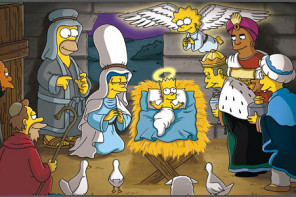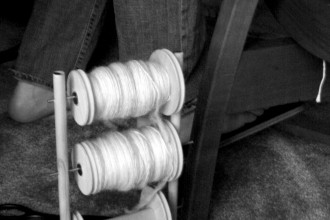In last week’s post, I explored some theological ideas from the first two Toy Story movies. This week I reflect on some of the numerous theological elements present in Toy Story 3.
Even though I expected the film to have rich material for reflection, I was surprised at just how much was there, and have had great difficulty in limiting my focus to something short enough for a post. Finally, I decided to start with Woody.
Unlike the first two films, in Toy Story 3 all the toys know who they are–no one has to be told “you are a toy”–and Woody in particular has finally come to perfect knowledge of his status as Andy’s toy, meant to be played with by him, but even more important simply to be there. While the other toys come to believe that their mission as Andy’s toys is over, Woody is not convinced. Even if their owner seems to have abandoned them, and even if he knows that every toy will eventually face this transition away from the child they have known, he sees that it is not his prerogative to decide when that mission is over. Although toys have freedom to choose their actions, they are ultimately dependent beings who exist to serve and bring happiness to their owners; it is through this service that they are themselves fulfilled.
Woody’s conviction is most vividly illustrated when he finds himself in Bonnie’s house. He quickly finds that Bonnie loves playing with toys, treats them well, and that her other toys have established a healthy community; it’s another toy heaven like Andy’s room was when he was young. But Woody refuses this heaven, even though he acknowledges loving it, because there are other toys that need saving, and because his owner was not the one who chose to place him there. His refusal echoes the words of Paul, who could have wished himself “accursed and cut off from Christ for the sake of [his] brothers” (Rom. 9:3). It also demonstrates an absolute trust in his owner, despite Andy’s lessened attention to him.
Being cut off both from Andy and from the new heaven he could have had becomes a very real possibility as Woody and his companions face infernal destruction at the dump. It is here that the aliens, who first entered the trilogy as comic relief, have their finest hour. The nature of their act deserves attention. They began in the first film as simple-minded cultists who revered “The Claw,” which would periodically choose one of them to “go on to a better life.” Of course, their belief wasn’t true, as the viewer could see that they were inside a vending machine and the claw was not the one doing the choosing; it was a person, who would not necessarily bring them to a better life (see Phillips, Sid). In the second film several of them were rescued by Mr. Potato Head during the course of the story, which made them grateful devotees of his.
It is clear that none of the aliens are particularly intelligent or capable, so they are not the ones anyone would expect to save someone from certain death. Yet they do, and they do so by making use of the one thing they understand: a claw. Strangely, the false story they had formerly held to ended up serving as a model for a situation they encountered in real life, and solved the problem of how to remove the friends they adored from the worst situation of their lives. The result is an almost literal deus ex machina that is a stunning instance of grace. There’s much more to unpack here, but there is one other subject that needs to be touched on, so I will move on.
No discussion of the film can be anywhere near complete without examining the fates of Andy’s toys and of Lotso. A commenter on my previous post linked to an article that dealt with some aspects of this subject, which is worth reading. My focus is a little different from that article’s though, as rather than dealing with the various possible afterlife destinations, I want to show the contrast between Woody’s and Lotso’s end.
Andy has decided to give his toys away to Bonnie, who will take good care of them and give them new life, and Woody places himself in the box as well to give Andy the option of giving him away too. He will not force the issue, but part of his loyalty to Andy is giving him the option to move on in life through loving renewal of all his toys’ existence in a new home. Andy’s final choice is indeed to give Woody away with the others, but he gives all of them one unexpected gift. As he hands each toy to Bonnie he tells her who they are–not just their names, but their qualities and virtues. And it turns out that as he describes them, so they are–Jessie is adventurous, Buzz is cool and capable, the Potato Heads love each other, Slinky is loyal . . . and most important, Woody is certainly the brave and virtuous hero that he was not when we first met him in Toy Story. They have become what Andy envisioned them as, because of the way he played with them. Bonnie will undoubtedly add her own flourishes to the descriptions, and new complexities of relationship will develop as they join with Bonnie’s other toys, but nothing has been lost.
Then there is Lotso. The toys’ victory in the first film involved delivering frightening justice to a toy torturer. Their victory in the second film was, first, to “steal” themselves from the thieving toy collector intent on selling the Roundup Gang to a museum. Second, it was to deliver the mint-condition Stinky Pete into the possession of a girl who liked to decorate her toys. These actions are all those of justice, and richly deserved by the villains. But they do not do the same to Lotso. Woody tells the other toys “he’s not worth it” and they let him go. Why this mercy? The balance of giving justice and mercy is always a difficult one to strike, but perhaps the films are suggesting that it is at least partly dependent on how much responsibility one has been given in a particular situation. The toys worked together to achieve victory in the previous two films, accepting their responsibility to get back where they belonged. So they also delivered justice to wrongdoers. But in Toy Story 3, they could do nothing to rescue themselves; their last hope was gone until their eucatastrophic escape thanks to the claw. So perhaps they decided that as their salvation had been out of their control, so too should be the delivery of justice.
What happens when Lotso is left to himself is his discovery by a garbage collector, who puts him on the front of his truck–not the most satisfactory place to be, to put it mildly. Ironically for the bear who had turned to evil in his anger over being replaced, the garbage collector picks him up because he remembers having had a Lots-O’-Huggin bear as a child. His coming torment of bugs and dirt is due precisely to being remembered. One wonders whether he will twist further into malice due to his torment, or perhaps will eventually become somewhat reconciled even in his place on a garbage truck due to the fact that someone, at least, has a remnant of affection for him. Such a question is irrelevant to the primary story of the film, but yet another jumping-off point for theological reflection.
I suspect this is more than enough material for comment, but if you have other theological reflections on the film, I’d love to hear them.






Great reflections — and particularly poignant given the fact that the story is, on the face of it, just a “toy story”. The fact that narratives celebrating virtuous character, duty, and faithfulness continue to persist in pop-culture is a miracle. The high-arts of painting, literary novels, theatre, and opera have, for over a century, often been dominated by duplicitous, conflicted, narcissitic, and dark characters. If Vasari wrote a “Lives of the Artists 1890-2010” he might find much to gossip about but, I fear, little to celebrate (at least in terms of the qualities embodied by Woody in Toy Story). The divide between the sometimes naive pop-culture ideals the soi disant realism of haute couture is fascinating. So many modern novels have a miserific vision — and the beatific vision seems sometimes to be confined to “toy” stories…
Good point. There is darkness in the world, and it needs to be explored, but the tendency of our culture today seems to be to focus only on the darkness, as if that’s all there is. Pixar counters this tendency with its recalling of, as you say, the beatific.
I would disagree on one point, though. I don’t think most pop culture today remembers the old ideals. It seems to me that most of the products of pop culture are trying to distract from darkness rather than overcome it. This is one reason why so many people today who discover good art come to believe the erroneous idea that good = dark: because at least dark art is not in denial. Pixar deals with the darkness, but manages to show that art solely occupied with it has failed to see the whole of reality.